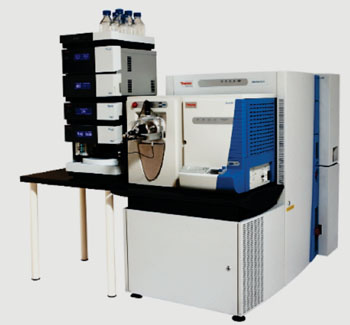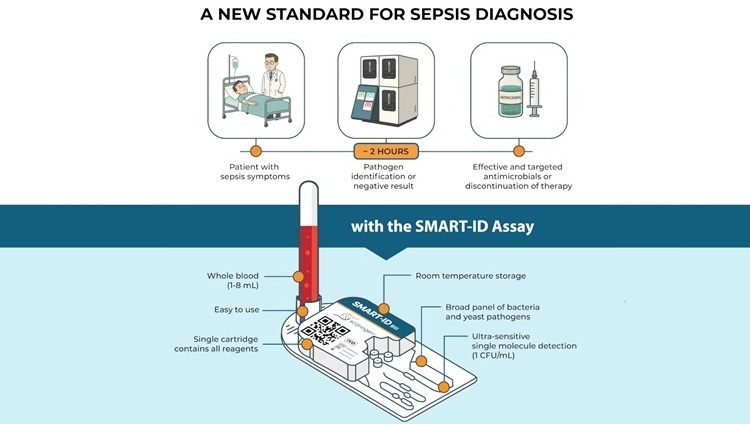Biomarker Identified in Breast and Prostate Cancers
|
By LabMedica International staff writers Posted on 25 Aug 2015 |

Image: The LTQ Orbitrap Elite mass spectrometer (Photo courtesy of Thermo Scientific).
A novel genetic biomarker has been identified responsible for the progression of many breast and prostate cancers and these finding could bolster efforts to better identify patients who respond to certain types of chemotherapy drugs that attack the most aggressive forms of cancer.
Metastatic dissemination is a multistep process that involves cell migration, invasion and growth at distant sites and the “amoeboid” phenotype has emerged as a migratory mechanism that facilitates metastasis. Amoeboid behavior is prominent at the invasive front of tumors, confers rapid migration rates and enables survival within the vasculature.
Scientists at Cedars-Sinai Medical Center (Los Angeles, CA, USA) and their colleagues investigated whether the loss of Diaphanous-related formin-3 (DIAPH3), frequently associated with metastatic breast and prostate cancers, correlates with increased sensitivity to taxanes, which are widely employed chemotherapies for patients with metastatic prostate and breast cancer.
Different patient cohorts were analyzed for DIAPH3 gene expression profiles and various other techniques were used in the study. These included the identification of DIAPH3 interactomes where tryptic peptides were extracted, concentrated, reconstituted in 0.1% formic acid, separated on a 25 cm EASY-Spray C18 column, and analyzed by an LTQ Orbitrap Elite mass spectrometer (Thermo Scientific; Waltham, MA, USA). Live cells were imaged using a Nikon Ti inverted confocal microscope (Nikon Instruments Inc.; Melville, NY, USA) coupled to a Spinning Disk head (Yokogawa Electric Corporation; Tokyo, Japan).
The scientists found that that loss of DIAPH3, frequently associated with metastatic breast and prostate cancers, correlated with increased sensitivity to taxanes. DIAPH3 interacted with microtubules (MT), and its loss altered several parameters of MT dynamics as well as decreased polarized force generation, contractility, and response to substrate stiffness. Silencing of DIAPH3 increased the cytotoxic response to taxanes in prostate and breast cancer cell lines. Analysis of drug activity for tubulin-targeted agents in the NCI-60 cell line panel revealed a uniform positive correlation between reduced DIAPH3 expression and drug sensitivity. Low DIAPH3 expression correlated with improved relapse-free survival in breast cancer patients treated with chemotherapeutic regimens containing taxanes.
Shlomo Melmed, MD, director of the Burns and Allen Research Institute at Cedar-Sinai, said, “By identifying cancer biomarkers, then customizing treatment plans for individuals based on this genetic information, we can greatly improve the effectiveness of cancer therapies. This customized plan replaces a one-size-fits-all approach to cancer treatment.” The study was published online on July 16, 2015, in the journal Scientific Reports.
Related Links:
Cedars-Sinai Medical Center
Thermo Scientific
Nikon Instruments Inc.
Metastatic dissemination is a multistep process that involves cell migration, invasion and growth at distant sites and the “amoeboid” phenotype has emerged as a migratory mechanism that facilitates metastasis. Amoeboid behavior is prominent at the invasive front of tumors, confers rapid migration rates and enables survival within the vasculature.
Scientists at Cedars-Sinai Medical Center (Los Angeles, CA, USA) and their colleagues investigated whether the loss of Diaphanous-related formin-3 (DIAPH3), frequently associated with metastatic breast and prostate cancers, correlates with increased sensitivity to taxanes, which are widely employed chemotherapies for patients with metastatic prostate and breast cancer.
Different patient cohorts were analyzed for DIAPH3 gene expression profiles and various other techniques were used in the study. These included the identification of DIAPH3 interactomes where tryptic peptides were extracted, concentrated, reconstituted in 0.1% formic acid, separated on a 25 cm EASY-Spray C18 column, and analyzed by an LTQ Orbitrap Elite mass spectrometer (Thermo Scientific; Waltham, MA, USA). Live cells were imaged using a Nikon Ti inverted confocal microscope (Nikon Instruments Inc.; Melville, NY, USA) coupled to a Spinning Disk head (Yokogawa Electric Corporation; Tokyo, Japan).
The scientists found that that loss of DIAPH3, frequently associated with metastatic breast and prostate cancers, correlated with increased sensitivity to taxanes. DIAPH3 interacted with microtubules (MT), and its loss altered several parameters of MT dynamics as well as decreased polarized force generation, contractility, and response to substrate stiffness. Silencing of DIAPH3 increased the cytotoxic response to taxanes in prostate and breast cancer cell lines. Analysis of drug activity for tubulin-targeted agents in the NCI-60 cell line panel revealed a uniform positive correlation between reduced DIAPH3 expression and drug sensitivity. Low DIAPH3 expression correlated with improved relapse-free survival in breast cancer patients treated with chemotherapeutic regimens containing taxanes.
Shlomo Melmed, MD, director of the Burns and Allen Research Institute at Cedar-Sinai, said, “By identifying cancer biomarkers, then customizing treatment plans for individuals based on this genetic information, we can greatly improve the effectiveness of cancer therapies. This customized plan replaces a one-size-fits-all approach to cancer treatment.” The study was published online on July 16, 2015, in the journal Scientific Reports.
Related Links:
Cedars-Sinai Medical Center
Thermo Scientific
Nikon Instruments Inc.
Latest Molecular Diagnostics News
- Ultrasensitive Method Detects Low-Frequency Cancer Mutations
- Blood Test Enables Non-Invasive Endometriosis Detection
- New Blood Biomarkers Help Diagnose Pregnancy-Linked Liver Complication
- Simple Urine Test to Revolutionize Bladder Cancer Diagnosis and Treatment
- Blood Test to Enable Earlier and Simpler Detection of Liver Fibrosis
- Genetic Marker to Help Children with T-Cell Leukemia Avoid Unnecessary Chemotherapy
- Four-Gene Blood Test Rules Out Bacterial Lung Infection
- New PCR Test Improves Diagnostic Accuracy of Bacterial Vaginosis and Candida Vaginitis
- New Serum Marker-Editing Strategy to Improve Diagnosis of Neurological Diseases
- World’s First Genetic Type 1 Diabetes Risk Test Enables Early Detection
- Blood Test to Help Low-Risk Gastric Cancer Patients Avoid Unnecessary Surgery
- First-Of-Its-Kind Automated System Speeds Myeloma Diagnosis
- Blood Protein Profiles Predict Mortality Risk for Earlier Medical Intervention
- First Of Its Kind Blood Test Detects Gastric Cancer in Asymptomatic Patients
- Portable Molecular Test Detects STIs at POC in 15 Minutes
- Benchtop Analyzer Runs Chemistries, Immunoassays and Hematology in Single Device
Channels
Clinical Chemistry
view channel
Online Tool Detects Drug Exposure Directly from Patient Samples
Doctors often rely on patient interviews and medical records to determine what medications a person has taken, but this information is frequently incomplete. People may forget drugs they used, take over-the-counter... Read more
Chemical Imaging Probe Could Track and Treat Prostate Cancer
Prostate cancer remains a leading cause of illness and death among men, with many patients eventually developing resistance to standard hormone-blocking therapies. These drugs often lose effectiveness... Read moreMolecular Diagnostics
view channel
Ultrasensitive Method Detects Low-Frequency Cancer Mutations
Liquid biopsy has emerged as a promising approach for cancer detection and treatment monitoring, although its clinical impact has been limited by the extremely low levels of tumor-derived DNA circulating in blood.... Read more
Blood Test Enables Non-Invasive Endometriosis Detection
Endometriosis is a chronic, complex, yet relatively common gynecological disorder, reportedly affecting 1 in 10 adult and adolescent women. Endometriosis causes tissue similar to the lining of the uterus... Read moreHematology
view channel
MRD Tests Could Predict Survival in Leukemia Patients
Acute myeloid leukemia is an aggressive blood cancer that disrupts normal blood cell production and often relapses even after intensive treatment. Clinicians currently lack early, reliable markers to predict... Read more
Platelet Activity Blood Test in Middle Age Could Identify Early Alzheimer’s Risk
Early detection of Alzheimer’s disease remains one of the biggest unmet needs in neurology, particularly because the biological changes underlying the disorder begin decades before memory symptoms appear.... Read more
Microvesicles Measurement Could Detect Vascular Injury in Sickle Cell Disease Patients
Assessing disease severity in sickle cell disease (SCD) remains challenging, especially when trying to predict hemolysis, vascular injury, and risk of complications such as vaso-occlusive crises.... Read more
ADLM’s New Coagulation Testing Guidance to Improve Care for Patients on Blood Thinners
Direct oral anticoagulants (DOACs) are one of the most common types of blood thinners. Patients take them to prevent a host of complications that could arise from blood clotting, including stroke, deep... Read moreImmunology
view channel
Routine Blood Test Can Predict Who Benefits Most from CAR T-Cell Therapy
CAR T-cell therapy has transformed treatment for patients with relapsed or treatment-resistant non-Hodgkin lymphoma, but many patients eventually relapse despite an initial response. Clinicians currently... Read more
New Test Distinguishes Vaccine-Induced False Positives from Active HIV Infection
Since HIV was identified in 1983, more than 91 million people have contracted the virus, and over 44 million have died from related causes. Today, nearly 40 million individuals worldwide live with HIV-1,... Read more
Gene Signature Test Predicts Response to Key Breast Cancer Treatment
DK4/6 inhibitors paired with hormone therapy have become a cornerstone treatment for advanced HR+/HER2– breast cancer, slowing tumor growth by blocking key proteins that drive cell division.... Read more
Chip Captures Cancer Cells from Blood to Help Select Right Breast Cancer Treatment
Ductal carcinoma in situ (DCIS) accounts for about a quarter of all breast cancer cases and generally carries a good prognosis. This non-invasive form of the disease may or may not become life-threatening.... Read moreMicrobiology
view channel
Blood-Based Diagnostic Method Could Identify Pediatric LRTIs
Lower-respiratory tract infections (LRTIs) are a leading cause of illness and death worldwide, and pneumonia is the leading infectious cause of death in children under five, claiming the lives of over... Read more
Rapid Diagnostic Test Matches Gold Standard for Sepsis Detection
Sepsis kills 11 million people worldwide every year and generates massive healthcare costs. In the USA and Europe alone, sepsis accounts for USD 100 billion in annual hospitalization expenses.... Read moreRapid POC Tuberculosis Test Provides Results Within 15 Minutes
Tuberculosis remains one of the world’s deadliest infectious diseases, and reducing new cases depends on identifying individuals with latent infection before it progresses. Current diagnostic tools often... Read more
Rapid Assay Identifies Bloodstream Infection Pathogens Directly from Patient Samples
Bloodstream infections in sepsis progress quickly and demand rapid, precise diagnosis. Current blood-culture methods often take one to five days to identify the pathogen, leaving clinicians to treat blindly... Read moreTechnology
view channel
Artificial Intelligence Model Could Accelerate Rare Disease Diagnosis
Identifying which genetic variants actually cause disease remains one of the biggest challenges in genomic medicine. Each person carries tens of thousands of DNA changes, yet only a few meaningfully alter... Read more
AI Saliva Sensor Enables Early Detection of Head and Neck Cancer
Early detection of head and neck cancer remains difficult because the disease produces few or no symptoms in its earliest stages, and lesions often lie deep within the head or neck, where biopsy or endoscopy... Read moreIndustry
view channel
Abbott Acquires Cancer-Screening Company Exact Sciences
Abbott (Abbott Park, IL, USA) has entered into a definitive agreement to acquire Exact Sciences (Madison, WI, USA), enabling it to enter and lead in fast-growing cancer diagnostics segments.... Read more



















